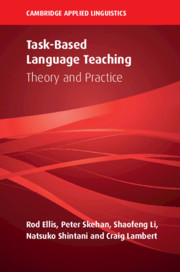Book contents
- Task-Based Language Teaching
- The Cambridge Applied Linguistics Series
- Task-Based Language Teaching
- Copyright page
- Contents
- Figures
- Tables
- Series Editors’ Preface
- Authors’ Preface
- Part I Introduction
- 1 The Pedagogic Background to Task-Based Language Teaching
- Part II Theoretical Perspectives
- Part III Pedagogical Perspectives
- Part IV Investigating Task-Based Programmes
- Part V Moving Forward
- Endnotes
- References
- Index
1 - The Pedagogic Background to Task-Based Language Teaching
from Part I - Introduction
Published online by Cambridge University Press: 07 October 2019
- Task-Based Language Teaching
- The Cambridge Applied Linguistics Series
- Task-Based Language Teaching
- Copyright page
- Contents
- Figures
- Tables
- Series Editors’ Preface
- Authors’ Preface
- Part I Introduction
- 1 The Pedagogic Background to Task-Based Language Teaching
- Part II Theoretical Perspectives
- Part III Pedagogical Perspectives
- Part IV Investigating Task-Based Programmes
- Part V Moving Forward
- Endnotes
- References
- Index
Summary
This chapter outlines a number of key issues that will be addressed more fully in subsequent chapters. We trace the origins of TBLT in communicative language teaching and second language acquisition research. We then examine the developments that have taken place in TBLT, pointing to the multiple influences that have helped to shape its evolution. We address key issues such as how to define ‘task’, how tasks have been classified, how they can be sequenced into a syllabus and how a complete lesson can be built around a task. We also discuss the use of tasks in computer-mediated language teaching and task-based assessment. We introduce the key construct of ‘focus-on-form’ and explain its importance in TBLT and consider the difference between ‘task-based’ and ‘task-supported’ language teaching.
- Type
- Chapter
- Information
- Task-Based Language TeachingTheory and Practice, pp. 3 - 26Publisher: Cambridge University PressPrint publication year: 2019
- 1
- Cited by

